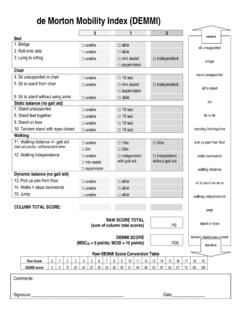Transcription of The Modified Falls Efficacy Scale (MFES) guidelines
1 Department of Human Services Working together to prevent Falls guidelines developed by: National Ageing Research Institute and North West Hospital Falls Clinic A one-page form, consisting of 14 questions each related to a particular activity (eg getting dressed, taking a bath, crossing roads etc). Unlike the original Falls Efficacy Scale (developed by Tinetti et al, 1990), this Scale includes a broader range of indoor and outdoor activities. The questions aim to determine how confidently seniors feel they are able to undertake each activity on a Scale of 0 (not confident at all) to 10 (completely confident).
2 An evaluation of the MFES was reported in: Hill, K., J. Schwarz, et al (1996). Fear of falling revisited. Archives of Physical Medicine and Rehabilitation 77: 1025-1029. These preliminary findings indicated that the MFES was both a reliable and valid measure of Falls self- Efficacy . (Downloadable) --- --- In 2005 the Department of Human Services funded the National Ageing Research Institute to review and recommend a set of Falls prevention resources for general use.
3 The materials used as the basis for this generic resource were developed by the National Ageing Research Institute and the North West Hospital Falls Clinic, Parkville (adapted from Tinetti et al., 1990). This and other Falls prevention resources are available from the department s Aged Care website at: The Modified Falls Efficacy Scale (MFES) guidelines Working together to prevent Falls Modified Falls Efficacy Scale (MFES) guidelines The guidelines aim to provide users with information to conduct and interpret the results obtained by the Modified Falls Efficacy Scale .
4 This information has been taken from the Manual for clinical outcome measurement in adult neurological physiotherapy (2nd edition, available from the Australian Physiotherapy Association). Type of measure: Self report measure of Falls Efficacy , also commonly called fear of falling. Modification of original 10 item Falls Efficacy Scale (Tinetti et al, 1990). Equipment required: 14 item questionnaire Time required to perform test: Varies, 5 15 minutes Test procedure: Has been reported as interviewer administered questionnaire (Hill et al, 1996).
5 Subject is asked to rate their confidence in performing each of 14 activities without falling on a 0 10 Scale . An overall score is calculated by averaging the scores for all items which were rated (ie score out of 10). Normative scores: Average score of (range 10) for sample of healthy women (mean age years, sd ) (Hill et al, 1999) Reliability: High retest reliability in older sample of fallers and non-fallers (ICC= ) (Hill et al, 1996). Validity: Significantly lower MFES score in female stroke subjects who had returned home and were community ambulant (mean score , sd ), compared to age matched controls (Hill, 1998).
6 Significantly lower MFES score in female Parkinson s disease subjects who were community ambulant (mean score , sd ), compared to age matched controls (Hill, 1998). Significantly lower MFES score in people with polio compared to aged and gender matched controls (Hill and Stinson, 2004). Improved MFES in high Falls risk older women who wore hip protectors (Cameron et al, 2000). In 2005 the Department of Human Services funded the National Ageing Research Institute to review and recommend a set of Falls prevention resources for general use.
7 The materials used as the basis for this generic resource were developed by the National Ageing Research Institute and the North West Hospital Falls Clinic, Parkville (adapted from Tinetti et al., 1990). This and other Falls prevention resources are available from the department s Aged Care website at: Strengths and limitations: appears sensitive to mild levels of loss of confidence needs further validation in neurological samples References: 1. Cameron I, Stafford B, Cumming R, Birks C, Kurrle S, Lockwood K, et al.
8 Hip protectors improve Falls self- Efficacy . Age and Ageing 2000; 29: 57-62. 2. Hill K, Schwarz J, Kalogeropoulos A, Gibson S. Fear of falling revisited. Archives of Physical Medicine and Rehabilitation 1996; 77:1025-1029. 3. Hill K. Studies of balance in older people. [PhD]. The University of Melbourne, 1998. 4. Hill K, Schwarz J, et al. Falls among healthy community dwelling older women: A prospective study of frequency, circumstances, consequences and prediction accuracy. Australian and New Zealand Journal of Public Health 1999; 23:41-8.
9 5. Hill KD, Stinson AT. A pilot study of Falls , fear of falling, activity levels and fall prevention actions in older people with polio. Aging Clinical and Experimental Research 2004; 16: 126-31. 6. Tinetti M, Richman D, Powell L. Falls Efficacy as a measure of fear of falling. Journal of Gerontology 1990; 45: P239-43.

